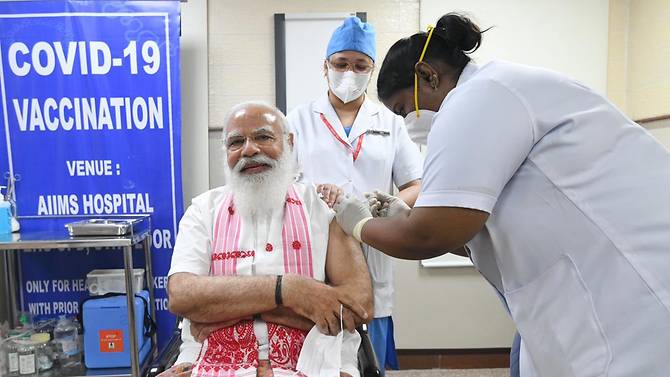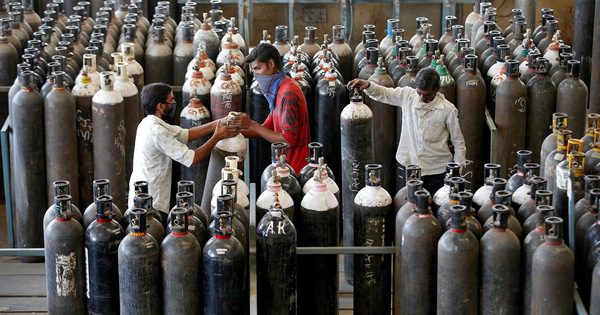The Joe Biden administration has also redirected its own order of AstraZeneca manufacturing supplies to India, which will allow it to make over 20 million doses of vaccine.
The US has dispatched its first batch of Covid-19 relief materials to India, including oxygen cylinders and regulators, Rapid Diagnostic Test kits and N95 masks. The White House has said the US would be sending supplies worth more than $100 million to India and “meet the urgent health needs of the Indian people”.

In a statement on Wednesday, US Agency for International Development (USAID) said, “The United States deployed the first of several emergency Covid-19 relief shipments to India. Arriving in New Delhi from Travis Air Force Base on the world’s largest military aircraft, the shipment includes 440 oxygen cylinders and regulators.”
“In addition, on this first flight, USAID has sent 960,000 Rapid Diagnostic Tests to identify infections early to help prevent the community spread of Covid-19, and 100,000 N95 masks to protect India’s frontline healthcare heroes,” the statement said.
The Joe Biden administration has also redirected its own order of AstraZeneca manufacturing supplies to India, which will allow it to make over 20 million doses of Covid-19 vaccine.
The US Centers for Disease Control and Prevention has also locally procured oxygen cylinders and will deliver them to support hospital systems in India.

The US is also providing the first tranche of a planned 20,000 treatment courses of the anti-viral drug Remdesivir to help treat hospitalised Covid-19 patients.
“The United States has stood shoulder to shoulder with the people of India for more than 70 years, and will continue to fight the Covid-19 pandemic together,” said the statement.
“Just as India sent assistance to the United States when US hospitals were strained early in the pandemic, the United States is now helping India during its time of need,” it further said.
Immediate US Emergency Covid-19 Assistance
The United States is providing:
Oxygen Support: An initial delivery of 1,100 cylinders will remain in India and can be repeatedly refilled at local supply centers, with more planeloads to come. The U.S. Centers for Disease Control and Prevention has also locally procured oxygen cylinders and will deliver them to support hospital systems in coordination with the Government of India.
Oxygen Concentrators: 1700 oxygen concentrators to obtain oxygen from ambient air. These mobile units provide options for flexible patient treatment.
Oxygen Generation Units (PSA Systems): Multiple large-scale units to support up to 20 patients each, and additional mobile units will provide an ability to target specific shortages. A team of U.S. experts will support these units, working hand-in-hand on the ground with Indian medical personnel
Personal Protective Equipment: 15 million N95 masks to protect both patients and Indian health care personnel.
Vaccine-Manufacturing Supplies: The U.S. has re-directed its own order of Astra Zeneca manufacturing supplies to India. This will allow India to make over 20 million doses of COVID-19 vaccine.
Rapid Diagnostic Tests (RDTs): 1 million rapid diagnostic tests the same type used by the White House — to provide reliable results in less than 15 minutes to help identify and prevent community spread.
Therapeutics: The first tranche of a planned 20,000 treatment courses of the antiviral drug remdesivir to help treat hospitalized patients.
Public Health Assistance: US CDC experts will work hand-in- hand with India’s experts in the following areas: laboratory, surveillance and epidemiology, bioinformatics for genomic sequencing and modeling, infection prevention and control, vaccine rollout, and risk communication.
US support for India from the outset of the pandemic:
The United States and India have closely worked together to respond to the COVID-19 pandemic. US Covid-19 assistance has reached more than 9.7 million Indians across more than 20 states and union territories, providing life-saving treatments, disseminating public health messages to local communities; strengthening case-finding and surveillance; and mobilizing innovative financing mechanisms to bolster emergency preparedness:
– Partnered with more than 1,000 Indian healthcare facilities to strengthen preparedness, including training of over 14,000 people on infection prevention and control.
– Helped keep more than 213,000 frontline workers safe — including risk mitigation training for doctors, nurses, midwives, community volunteers, sanitation workers, and others who are actively responding to COVID-19 in India.
– Launched joint public messaging with UNICEF on COVID prevention that has reached more than 84 million people.
– Provided 200 state-of-the-art ventilators to 29 healthcare facilities in 15 states to care for critically-ill COVID-19 patients.
US-India health partnership: Seven decades strong
– For seventy years, US public health experts from across the government, including USAID, HHS, CDC, FDA, and NIH, have worked in partnership with Indian officials to improve the health of India’s most vulnerable communities and the well-being of its people.
– Over the last 20 years, US foreign assistance to India has exceeded $2.8 billion, including more than $1.4 billion for health care.
– The United States, India, and other partners have worked together to reduce new HIV infections by 37 percent between 2010 and 2019.
– Since 1998, the United States and India have worked together to combat tuberculosis (TB) through improved patient-centered diagnosis, treatment and prevention, helping treat 15 million people with the disease.
– In the last five years, the United States has helped 40 million pregnant women receive vital health information and services.
– The United States, in partnership with the Government of India and World Health Organization, has supported initiatives at the District, State and National level to build frontline disease detection capacity.
– The United States and India are working together to advance global health security and fight outbreaks before they become pandemics.
According to indiatoday.in. Source of photos: internet







